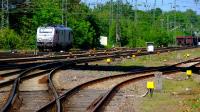Researchers aim to improve the transport of goods within cities

Solutions are being developed within the international UrbFRail project involving Poland, Germany, and Sweden, fot. pixabay
It is to be sustainable, yet fast, efficient, and reliable. How can this effect be achieved? The answer may be... rail. As part of the UrbFRail project, tools are being developed that will improve the creation and revitalization of freight rail hubs in cities.
Over the last thirty years, internal freight rail transport has significantly decreased in importance. This is primarily the result of deindustrialization following the collapse of socialist countries and the commercialization of rail transport. Therefore, part of the existing infrastructure ceased to be used. However, this is beginning to change due to the need to reduce carbon dioxide emissions. Rail becomes an opportunity for more sustainable transport.
Utilizing available infrastructure
The development of rail hubs is a complex process that requires consideration of many factors, such as infrastructure, spatial planning, economic feasibility, as well as funding and management. Political decisions, which may involve large public investments, require a solidly prepared concept and development process.
For a long time, the rail transport of goods within cities was not a priority, so planners may lack specialized knowledge. Therefore, guidelines are needed. Researchers come to the rescue here.
To meet this challenge, as part of the international UrbFRail project, in which countries such as Poland, Sweden, and Germany participate, a set of tools is being created to support planners in selecting appropriate areas for freight rail hubs and assisting in the revitalization of these areas: a screening tool for urban rail transport and a tool for the development of urban rail transport. Both were designed with their universality in mind and the possibility of application in similar cases in different cities in Europe, in this project in the Baltic states. Additionally, thanks to the Urban Rail Freight Learning Platform educational platform, planners will have access to these tools and will be able to use them in their daily work.
Contribution of the team from the Warsaw University of Technology
Specialists from the Warsaw University of Technology from the Faculty of Transport (Andrzej Kochan, PhD) and the Faculty of Architecture (Krystian Kwieciński, PhD) are working on the Screening Tool. Its goal is to highlight key aspects that should be considered when assessing the potential of a given place to create an urban freight rail hub.
– This tool allows for a preliminary assessment of the site's potential, based on existing railway sidings or the possibility of their revitalization towards a rail hub – says Andrzej Kochan, PhD. – The assessment results are the basis for further analysis, and the report generated by the tool contains conclusions and answers provided.’
Planners dealing with the spatial management of cities, city authorities, persons responsible for the development of railway lines, infrastructure managers, and persons managing existing sidings will be able to use the tool.
– The level of detail of the answers provided is adjusted to the analysis goals, and in the case of inadequate questions, answers may be omitted or justified by a lack of information – points out Krystian Kwieciński, PhD.
The UrbFrail project is the result of the commitment of three countries: Poland, Germany, and Sweden, which aim to improve the quality of life of their citizens through innovative solutions in the area of revitalizing railway sidings within urban agglomerations. The project received financial support from the European Union Interreg Baltic Sea program (500,000 euros) and the European Regional Development Fund (400,000 euros). Project partners: Senate Department for Environment, Transport, Urban Development, Consumer Protection, and Climate Action (Germany), Warsaw University of Technology (Poland), City of Stockholm (Sweden), Swedish Transport Administration (Sweden), Upper Silesian-Zagłębie Metropolis (Poland), Lindholmen Science Park AB (Sweden), Royal Institute of Technology KTH (Sweden).
More information about the project can be found on the interreg-baltic.eu/project/urbfrail.









